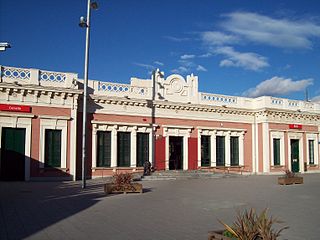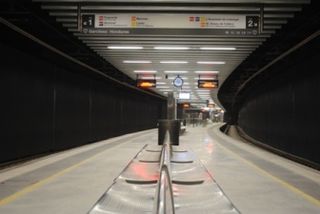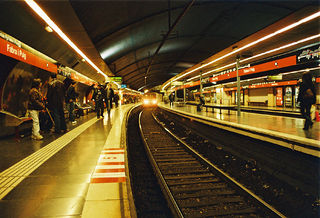
Line 1, shortened to L1, coloured red and often simply called Línia vermella, is the second oldest Barcelona Metro line, after line L3. It is the longest line of the Barcelona Metro, and links L'Hospitalet de Llobregat and Santa Coloma de Gramenet. Originally operated by the independent Ferrocarril Metropolitano Transversal de Barcelona, it is today operated by Transports Metropolitans de Barcelona (TMB) and is part of the ATM fare-integrated main transport system. L1 is the only metro line in Spain to use Iberian gauge tracks, as used by most Spanish main line railways.

Cornellà Centre, also simply known as Cornellà, is a Rodalies de Catalunya and Barcelona Metro station, as well as Trambaix tram stop. It is located in the city centre of the Cornellà de Llobregat municipality, to the south-west of Barcelona, in Catalonia, Spain.

La Sagrera-Meridiana, simply known as La Sagrera, is an interchange complex underneath Avinguda Meridiana, in the Barcelona district of Sant Andreu, in Catalonia, Spain. It consists of a Rodalies de Catalunya station and three Barcelona Metro stations. The Rodalies de Catalunya station is located in the Meridiana Tunnel on the Lleida to Barcelona via Manresa railway, between Sant Andreu Arenal and Arc de Triomf, and is operated by Renfe Operadora. It is served by Barcelona commuter rail service lines R3 and R4, as well as regional rail line R12. The Barcelona Metro stations are on lines 1 (L1) and 5 (L5), as well as the northern section of line 9/10, and are operated by Transports Metropolitans de Barcelona (TMB). On the L1, the station is between Navas and Fabra i Puig, on the L5 between Camp de l'Arpa and Congrés, and on the L9/L10 between Plaça Maragall (future) and Sagrera - TAV. The station is also projected to become the terminus of the L4 once the extension from La Pau opens. A number of interurban bus services stop near the station.


Sant Andreu is a Rodalies de Catalunya station in the Sant Andreu district of Barcelona. It is served by Barcelona commuter rail service lines R2 and R2 Nord, as well as regional line R11. Passengers can also commute here to Barcelona Metro line 1 station Sant Andreu. It is located completely over ground.

Barcelona El Clot-Aragó is a Rodalies de Catalunya station in El Camp de l'Arpa del Clot, in the Sant Martí district of Barcelona in Catalonia, Spain. It is served by Barcelona commuter rail service lines R1, R2 and R2 Nord, as well as Girona commuter rail service line RG1 and regional line R11. Passengers can commute here to Barcelona Metro station Clot. Like its metro counterpart, the station is completely underground, under Carrer d'Aragó and Avinguda Meridiana.

Arc de Triomf is a Rodalies de Catalunya and Barcelona Metro interchange complex. It is named after the adjacent triumphal arch of the same name near which it is situated, in the Barcelona district of Eixample in Catalonia, Spain. The Rodalies station is served by Barcelona commuter rail service lines R1, R3 and R4, as well as Girona commuter rail service line RG1 and regional line R12. The Barcelona Metro station is served by TMB-operated line L1.

Fabra i Puig is a Barcelona Metro station, on L1, located in the Sant Andreu district of Barcelona, below Avinguda Meridiana between Carrer de Concepció Arenal i Passeig de Fabra i Puig. It opened in 1954, with the extension of the aforementioned line from Sagrera to this station. Passengers can commute here for the Renfe-operated Sant Andreu Arenal railway station. It's named after Passeig de Fabra i Puig, one of the main thoroughfares of the area.

The R1 is a line of Rodalies de Catalunya's Barcelona commuter rail service, operated by Renfe Operadora. It runs northwards from the Barcelona area to the southern limits of the province of Girona, passing through the coastal Maresme region. Since 2014, some services have been extended further north towards Portbou, near the French border. These services are designated RG1 and are considered part of the Girona commuter rail service. The line had an annual ridership of 28 million in 2016, achieving an average weekday ridership of 102,214 according to 2008 data.

The R2 is a line of Rodalies de Catalunya's Barcelona commuter rail service, operated by Renfe Operadora. It is a major north–south axis in the Barcelona metropolitan area, running from the southern limits of the province of Girona to the northern limits of the province of Tarragona, via Barcelona. North of Barcelona, the line uses the Barcelona–Cerbère railway, running inland through the Vallès Oriental region. South of Barcelona, it uses the conventional Madrid–Barcelona railway, running along the coast through the Garraf region. The R2 had an annual ridership of 33.6 million in 2016, achieving an average weekday ridership of 125,948 according to 2008 data, which makes it the busiest line of the Barcelona commuter rail service.

The R3 is a line of Rodalies de Catalunya's Barcelona commuter rail service, operated by Renfe Operadora. It runs northwards from the Barcelona area to the French border town of Latour-de-Carol, passing through the Vallès Oriental, Osona and Ripollès regions. With a total line length of 165.9 kilometres (103.1 mi), it extends notably beyond the limits of the Barcelona metropolitan area, reaching the Pyrenees mountains. According to 2008 data, the line's average weekday ridership is 22,841.

The R4 is a line of Rodalies de Catalunya's Barcelona commuter rail service, operated by Renfe Operadora. It runs northwards from the northern limits of the province of Tarragona to Barcelona, passing through the inland Alt Penedès region. The line then continues towards central Catalonia, describing a U-shaped route through the Barcelona area. According to 2008 data, the line's average weekday ridership is 105,935, the highest on any line of the Barcelona commuter rail service after the R2.

The R7 is a line of Rodalies de Catalunya's Barcelona commuter rail service, operated by Renfe Operadora. It links Sant Andreu Arenal railway station in northern Barcelona with Cerdanyola Universitat railway station, which serves the Bellaterra campus of the Autonomous University of Barcelona. The R7 shares tracks for most of its length with Barcelona commuter rail service lines R3 and R4, as well as regional rail line R12. According to 2010 data, the line's average weekday ridership is 8,140.

Airport T2 is both a Rodalies de Catalunya commuter rail station and a Barcelona Metro station serving terminal complex T2 of Barcelona–El Prat Airport. They are located adjacent to the airport's terminal T2B, in the municipality of El Prat de Llobregat, to the southwest of Barcelona, in Catalonia, Spain. The Rodalies de Catalunya station is the southern terminus of the current rail link coming from El Prat de Llobregat railway station. It is operated by Renfe Operadora and is served by Barcelona commuter rail service line R2 Nord. The metro station is on the airport branch of Barcelona Metro line 9 (L9) and is operated by Transports Metropolitans de Barcelona (TMB).

Rodalies de Catalunya is the main commuter and regional rail system in the Spanish autonomous community of Catalonia. It is administered by the Government of Catalonia and operated by the national rail operator Renfe Operadora. The system consists of 17 service lines chiefly centred in the Barcelona area, serving a total of 203 stations throughout Catalonia, with an average number of 1,000 trains running on it every day. In 2016, it had an annual ridership of 117 million.

The R8 is a line of Rodalies de Catalunya's Barcelona commuter rail service, operated by Renfe Operadora. It runs hourly between Martorell and Granollers across the Vallès Occidental region, spanning 40 kilometres (25 mi) and eight stations. The R8 primarily uses the Castellbisbal–Mollet-Sant Fost railway, as well as the Sant Vicenç de Calders–Vilafranca del Penedès–Barcelona and Barcelona–Cerbère railways on its southern and northern ends, respectively. It is currently the only line of the Barcelona commuter rail service entirely bypassing Barcelona. The trains operating on the line are Civia electrical multiple units (EMU).

Bellvitge is a Rodalies de Catalunya commuter rail station serving the neighborhood of the same name, in the L'Hospitalet de Llobregat municipality, to the south-west of Barcelona, in Catalonia, Spain. It is on the conventional Madrid–Barcelona railway, between El Prat de Llobregat and Barcelona Sants, and is served by all trains on Barcelona commuter rail service lines R2 and R2 Nord, as well as some R2 Sud trains. Some trains on regional line R15 also call at the station.

The R11 is a line of Rodalies de Catalunya's regional rail service, operated by Renfe Operadora. It runs northwards from the Barcelona area to the French border town of Cerbère, passing through the Vallès Oriental, Selva, Gironès and Alt Empordà regions. With a total line length of 172 kilometres (107 mi), it extends notably beyond the limits of the Barcelona metropolitan area, reaching the Pyrenees mountains.

The R16 is a line of Rodalies de Catalunya's regional rail service, operated by Renfe Operadora. It runs southwards from the Barcelona area to the town of Tortosa, passing through the Vallès Occidental, Baix Llobregat, Garraf, Baix Penedès, Camp de Tarragona, Baix Ebre and Montsià regions. With a total line length of 172 kilometres (107 mi), it extends notably beyond the limits of the Barcelona metropolitan area, along the Mediterranean coast.
The R17 is a line of Rodalies de Catalunya's regional rail service, operated by Renfe Operadora. It runs southwards from the Barcelona area to Port Aventura, near the seaside resort of Salou, passing through the Vallès Occidental, Baix Llobregat, Garraf, Baix Penedès, Camp de Tarragona, Baix Ebre and Montsià regions. R17 trains run primarily on the Valencia−Sant Vicenç de Calders and Madrid–Barcelona railway, using Port Aventura as their southernmost terminus, and Barcelona Estació de França as its northern one. They use the Aragó Tunnel in Barcelona, where they share tracks with Rodalies de Catalunya's Barcelona suburban lines R2, R2 Nord and R2 Sud and regional rail lines R11, R13, R14, R15 and R16, calling at Sants and Passeig de Gràcia stations, while they continue to share tracks with Barcelona commuter rail service R2 Sud as far as Sant Vicenç de Calders, and with the Tarragona commuter rail service RT2 from Sant Vicenç de Calders to Port Aventura.




















